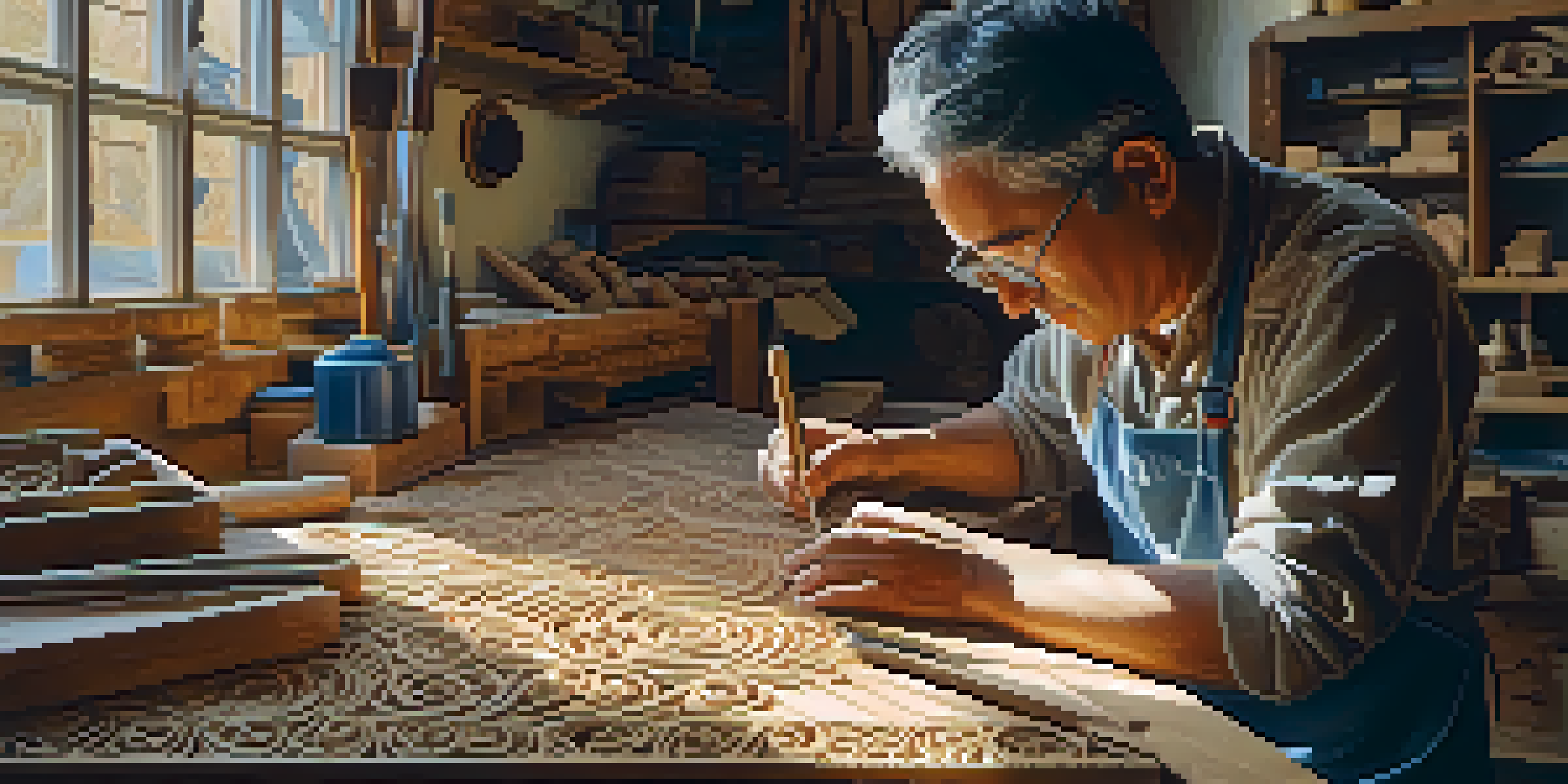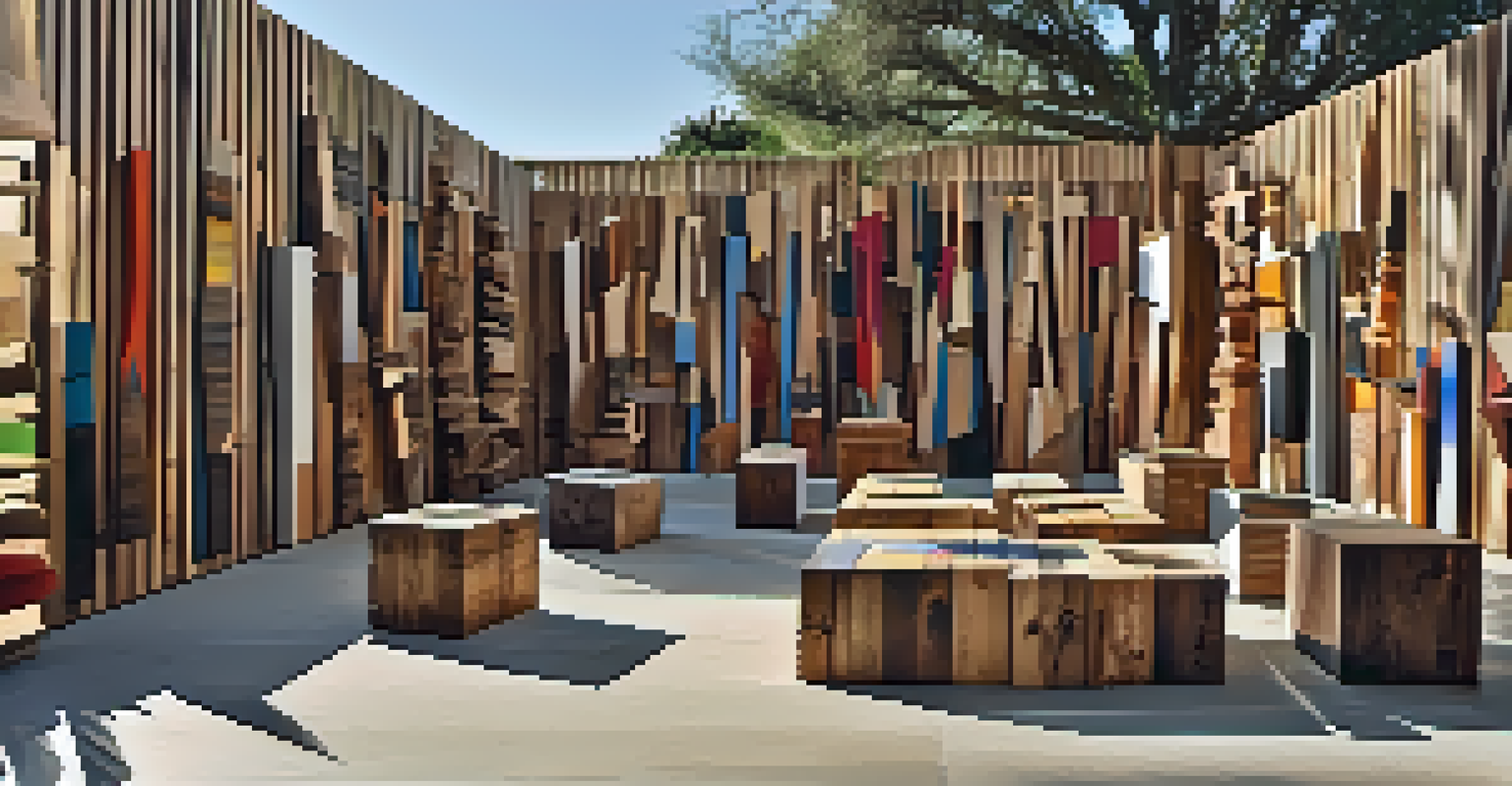Cultural Narratives in Wood: Carving as Storytelling Medium

The Art of Wood Carving: A Timeless Tradition
Wood carving has been a cherished craft for centuries, intertwining artistry with cultural significance. From ancient civilizations to modern artisans, carving has served as a method of storytelling, preserving the narratives of cultures across the globe. Each piece tells a story, reflecting the values, beliefs, and history of its creators.
Wood carving is a way of expressing the inexpressible.
In many cultures, wood is more than just a material; it’s a canvas for expression. Carving transforms a simple block of wood into intricate designs that embody the essence of a community's identity. This connection to the past makes wood carving a powerful medium for storytelling, bridging generations through shared narratives.
As we delve deeper into the world of wood carving, we can appreciate how these artistic expressions serve not only as decorative items but also as vessels for cultural memory. Each carve, each detail, is a reminder of stories that shape who we are and where we come from.
Cultural Significance of Wood Carving Around the World
Across various cultures, wood carving has unique meanings and traditions that reflect local beliefs and practices. For instance, in African cultures, wooden masks are often carved to represent spirits or ancestors, used in rituals to connect the spiritual and physical worlds. Similarly, Native American tribes create totem poles that narrate clan stories, showcasing heritage and identity.

In Asia, intricate woodwork can be found in temples and shrines, where carvings symbolize protection, prosperity, and reverence. These cultural artifacts serve not only as artistic expressions but also as conduits for spiritual beliefs and communal values. Each region’s approach to wood carving tells us much about their history and worldviews.
Wood Carving as Cultural Storytelling
Wood carving serves as a powerful medium for storytelling, reflecting the history and values of diverse cultures.
By understanding these cultural significances, we can appreciate the depth of storytelling embedded in wood carvings. They are more than mere decorations; they are profound statements of identity, connection, and continuity within diverse communities.
Techniques That Bring Stories to Life
The techniques used in wood carving can vary widely, but each method contributes to how stories are told through the medium. Traditional hand-carving techniques involve chiseling and gouging wood to create detailed designs, while modern methods might incorporate power tools for precision. Regardless of the technique, the artist's intent remains crucial in conveying narrative.
Art is the most beautiful of all lies; it is a way to tell stories that cannot be told.
For example, relief carving creates a three-dimensional effect, allowing the viewer to engage with the piece more intimately. This technique can evoke emotions and invite interpretations, adding layers to the storytelling experience. The choice of technique not only affects the aesthetics but also enhances the narrative depth.
Ultimately, the skillful application of these techniques allows artists to breathe life into their stories. Each curve and angle becomes a part of the narrative, connecting the observer to the rich tapestry of cultural traditions that wood carvings represent.
Symbolism in Wood Carving: A Language of Its Own
Symbols play a crucial role in wood carving, conveying complex ideas and emotions without the need for words. Different shapes, patterns, and figures can mean various things across cultures, often drawing from nature or mythology. For instance, a spiral might symbolize growth and evolution, while animal carvings can represent strength or protection.
These symbols serve as a visual language, allowing viewers to connect with the stories on a deeper level. Understanding the symbolism in wood carvings can enhance our appreciation of the craftsmanship and the narratives behind each piece. It’s fascinating how a single carving can encapsulate an entire story through carefully chosen symbols.
Symbolism Enhances Carving Narratives
The use of symbols in wood carving creates a visual language that deepens the connection between the artwork and its cultural significance.
As we explore the realm of symbolism in wood carving, we recognize its power to transcend language barriers. This universal aspect of storytelling enriches our experience and deepens our connection to the cultures they represent.
Wood as a Sustainable Medium for Storytelling
In recent years, the conversation around sustainability has become increasingly important, and wood carving is no exception. Carving from sustainably sourced wood not only honors the material but also ensures that future generations can enjoy the art form. This commitment to sustainability adds another layer to the storytelling aspect, as artists reflect on their responsibility towards the environment.
Moreover, the use of reclaimed wood in carving projects has gained popularity, allowing artists to give new life to discarded materials. This practice not only reduces waste but also infuses the pieces with a history of their own, creating a dialogue between the past and present. Each carving becomes a testament to both artistry and ecological mindfulness.
By embracing sustainability, wood carving can continue to tell stories for years to come. Artists who prioritize eco-friendly practices contribute to a larger narrative about preserving our planet while celebrating cultural heritage through their craft.
The Role of Storytelling in Contemporary Wood Carving
In the modern world, wood carving continues to evolve, with contemporary artists exploring new themes and narratives. This evolution often reflects societal changes, addressing issues such as identity, migration, and cultural fusion. By incorporating personal and political stories into their work, artists are keeping the tradition alive while making it relevant to today's audience.
Through exhibitions and public installations, contemporary wood carvers are engaging with broader communities, inviting dialogue around the themes depicted in their work. This interaction not only educates the public about the cultural significance of wood carving but also fosters a sense of connection among diverse audiences.
Sustainability in Wood Carving Art
Emphasizing sustainable practices in wood carving not only honors the craft but also ensures its longevity for future generations.
The incorporation of storytelling into contemporary wood carving serves as a reminder that these narratives are not static. They adapt and change, reflecting the dynamic nature of culture itself, ensuring that wood carving remains a vital medium for expression.
Preserving Cultural Narratives Through Wood Carving Education
Education plays a crucial role in preserving the art of wood carving and its rich narratives. Workshops, classes, and community programs are essential for passing down techniques and stories to new generations. By engaging young artists, we ensure that the cultural narratives embedded in wood carving do not fade away but continue to thrive.
Many institutions are now incorporating wood carving into their art curricula, emphasizing its historical and cultural significance. This educational approach not only teaches technical skills but also fosters a deeper understanding of the stories behind the art form. Engaging with these narratives can inspire creativity and a sense of pride in one’s heritage.

As we invest in wood carving education, we contribute to the preservation of cultural stories that define communities. By nurturing the next generation of wood carvers, we ensure that these narratives live on, continuing to enrich our understanding of diverse cultures.